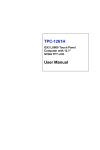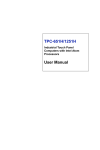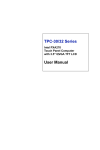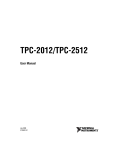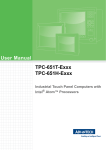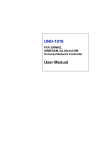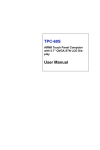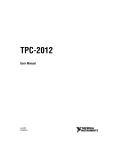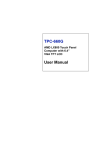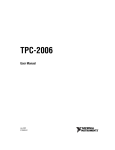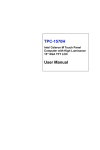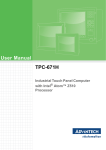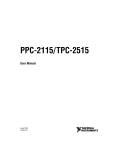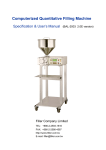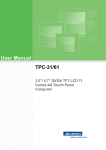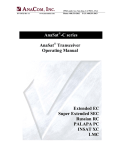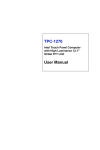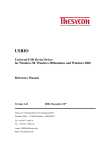Download TPC-651H/1251H User Manual
Transcript
TPC-651H/1251H Industrial Touch Panel Computers with Intel Atom Processors User Manual Copyright The documentation and the software included with this product are copyrighted 2010 by Advantech Co., Ltd. All rights are reserved. Advantech Co., Ltd. reserves the right to make improvements in the products described in this manual at any time without notice. No part of this manual may be reproduced, copied, translated or transmitted in any form or by any means without the prior written permission of Advantech Co., Ltd. Information provided in this manual is intended to be accurate and reliable. However, Advantech Co., Ltd. assumes no responsibility for its use, nor for any infringements of the rights of third parties, which may result from its use. Acknowledgements Intel and Pentium are trademarks of Intel Corporation. Microsoft Windows and MS-DOS are registered trademarks of Microsoft Corp. All other product names or trademarks are properties of their respective owners. This Manual Covers the Following Models • TPC-651H • TPC-1251H Part No. 2003065101 2nd Edition Printed in Taiwan June 2010 TPC-651H/1251H User Manual ii Product Warranty (2 years) Advantech warrants to you, the original purchaser, that each of its products will be free from defects in materials and workmanship for two years from the date of purchase. This warranty does not apply to any products which have been repaired or altered by persons other than repair personnel authorized by Advantech, or which have been subject to misuse, abuse, accident or improper installation. Advantech assumes no liability under the terms of this warranty as a consequence of such events. Because of Advantech’s high quality-control standards and rigorous testing, most of our customers never need to use our repair service. If an Advantech product is defective, it will be repaired or replaced at no charge during the warranty period. For out-of-warranty repairs, you will be billed according to the cost of replacement materials, service time and freight. Please consult your dealer for more details. If you think you have a defective product, follow these steps: 1. Collect all the information about the problem encountered. (For example, CPU speed, Advantech products used, other hardware and software used, etc.) Note anything abnormal and list any onscreen messages you get when the problem occurs. 2. Call your dealer and describe the problem. Please have your manual, product, and any helpful information readily available. 3. If your product is diagnosed as defective, obtain an RMA (return merchandize authorization) number from your dealer. This allows us to process your return more quickly. 4. Carefully pack the defective product, a fully-completed Repair and Replacement Order Card and a photocopy proof of purchase date (such as your sales receipt) in a shippable container. A product returned without proof of the purchase date is not eligible for warranty service. 5. Write the RMA number visibly on the outside of the package and ship it prepaid to your dealer. iii CE This product has passed the CE test for environmental specifications when shielded cables are used for external wiring. We recommend the use of shielded cables. This kind of cable is available from Advantech. Please contact your local supplier for ordering information. FCC Class A This equipment has been tested and found to comply with the limits for a Class A digital device, pursuant to Part 15 of the FCC Rules. These limits are designed to provide reasonable protection against harmful interference when the equipment is operated in a commercial environment. This equipment generates, uses and can radiate radio frequency energy and, if not installed and used in accordance with the instruction manual, may cause harmful interference to radio communications. Operation of this equipment in a residential area is likely to cause harmful interference in which case the user will be required to correct the interference at his own expense. Technical Support and Assistance Step 1. Visit the Advantech web site at www.advantech.com/support where you can find the latest information about the product. Step 2. Contact your distributor, sales representative, or Advantech's customer service center for technical support if you need additional assistance. Please have the following information ready before you call: - Product name and serial number - Description of your peripheral attachments - Description of your software (operating system, version, application software, etc.) - A complete description of the problem - The exact wording of any error messages TPC-651H/1251H User Manual iv Safety Instructions 1. Read these safety instructions carefully. 2. Keep this User's Manual for later reference. 3. Disconnect this equipment from any AC outlet before cleaning. Use a damp cloth. Do not use liquid or spray detergents for cleaning. 4. For plug-in equipment, the power outlet socket must be located near the equipment and must be easily accessible. 5. Keep this equipment away from humidity. 6. Put this equipment on a reliable surface during installation. Dropping it or letting it fall may cause damage. 7. The openings on the enclosure are for air convection. Protect the equipment from overheating. DO NOT COVER THE OPENINGS. 8. Make sure the voltage of the power source is correct before connecting the equipment to the power outlet. 9. Position the power cord so that people cannot step on it. Do not place anything over the power cord. 10. All cautions and warnings on the equipment should be noted. 11. If the equipment is not used for a long time, disconnect it from the power source to avoid damage by transient overvoltage. 12. Never pour any liquid into an opening. This may cause fire or electrical shock. 13. Never open the equipment. For safety reasons, the equipment should be opened only by qualified service personnel. 14. If one of the following situations arises, get the equipment checked by service personnel: a. The power cord or plug is damaged. b. Liquid has penetrated into the equipment. c. The equipment has been exposed to moisture. d. The equipment does not work well, or you cannot get it to work according to the user's manual. e. The equipment has been dropped and damaged. f. The equipment has obvious signs of breakage. 15. DO NOT LEAVE THIS EQUIPMENT IN AN ENVIRONMENT WHERE THE STORAGE TEMPERATURE MAY GO BELOW v 20° C (-4° F) OR ABOVE 60° C (140° F). THIS COULD DAMAGE THE EQUIPMENT. THE EQUIPMENT SHOULD BE IN A CONTROLLED ENVIRONMENT. 16. CAUTION: DANGER OF EXPLOSION IF BATTERY IS INCORRECTLY REPLACED. REPLACE ONLY WITH THE SAME OR EQUIVALENT TYPE RECOMMENDED BY THE MANUFACTURER, DISCARD USED BATTERIES ACCORDING TO THE MANUFACTURER'S INSTRUCTIONS. The sound pressure level at the operator's position according to IEC 7041:1982 is no more than 70 dB (A). DISCLAIMER: This set of instructions is given according to IEC 704-1. Advantech disclaims all responsibility for the accuracy of any statements contained herein. Caution! Danger of explosion if battery is incorrectly replaced. Replace only with the same or equivalent type recommended by the manufacturer. Dispose of used batteries according to the manufacturer's instructions. TPC-651H/1251H User Manual vi Contents Chapter 1 General Information ....................................... 2 1.1 1.2 Introduction ....................................................................... 2 Specifications .................................................................... 3 1.2.1 1.2.2 1.2.3 1.3 1.4 1.5 1.6 System Kernel ................................................................ 3 I/O Ports ......................................................................... 3 Safety and Environment ................................................. 3 LCD Specifications ........................................................... 4 Touchscreen Specifications............................................... 4 Power................................................................................. 4 I/O Ports Arrangement ...................................................... 5 Figure 1.1:TPC-651H - I/O Port Arrangement .............. 5 Figure 1.2:TPC-1251H - I/O Port Arrangement ............ 5 1.7 Panel Mounting ................................................................. 6 1.8 Dimensions and Cutout ..................................................... 6 Figure 1.3:Panel Mounting ............................................ 6 Figure 1.4:TPC-651H Dimensions ................................ 7 Figure 1.5:TPC-1251H Dimensions .............................. 8 Chapter 2 System Setup.................................................. 10 Figure 2.1:Unpack the Package ................................... 10 Figure 2.2:Install CompactFlash Memory Card .......... 11 Figure 2.3:Power Connector and Power Lines ............ 11 Figure 2.4:Power Receptor & Button Pin Assignment 11 Chapter 3 Features in Windows XP Embedded........... 14 3.1 3.2 EWF ................................................................................ 14 HORM............................................................................. 15 Appendix A Serial Port Settings........................................ 18 A.1 A.2 COM1/ COM2 Connector Definition ............................. 18 RS-485 / RS-422 Setting ................................................. 19 Appendix B Watchdog Timer B.1 B.2 Programming..... 24 Overview ......................................................................... 24 Watchdog Timer Programming....................................... 25 Figure B.1:Watchdog timer programming procedure .. 25 Table B.1:Watchdog Timer Registers ......................... 26 B.3 Example Programs .......................................................... 27 Appendix C Watchdog Timer Programming on WinCE 34 C.1 DeviceIOControl ............................................................. 34 C.1.1 C.2 Parameters .................................................................... 35 How to Use the Control Code ......................................... 36 C.2.1 C.2.2 C.2.3 IOCTL _WDT_ENABLE: ........................................... 36 IOCTL _WDT_DISABLE: .......................................... 36 IOCTL_WDT_STROBE: ............................................ 36 vii Table of Contents C.2.4 C.2.5 C.2.6 C.3 IOCTL_WDT_GETTIMEOUT: .................................. 37 IOCTL_WDT_SETTIMEOUT: .................................. 37 IOCTL_WDT_REBOOT: ........................................... 37 Examples ......................................................................... 38 TPC-651H/1251H User Manual viii CHAPTER 2 1 General Information Chapter 1 General Information 1.1 Introduction The TPC-651H and TPC-1251H Touch Panel Computers are state-of-theart Human Machine Interfaces featuring 5.7" and 12.1 displays with Intel Atom eMenlow XL processors and the following key features: • Fanless By using a low-power processor, the system does not have to rely on fans, which often are unreliable and causes dust to circulate inside the equipment. • Bright Display The TFT LCD display suits industrial demands for clear interfaces. • Wide Operating Temperature & Isolation Protection These products provide a -20~60° C wide operating temperature solution and complete isolation protection for their serial ports. • Windows CE Support In addition to the OS support of Windows XP, Advantech offers platform support for Windows CE and Windows XP embedded. The optional Windows CE operating system specifically for Industrial Touch Panel Computers is also available. • Energy Star Approval TPC-651H/1251H User Manual 2 1.2 Specifications 1.2.1 System Kernel • CPU: Intel Atom Z520 1.33GHz • BIOS: Award 4 Mbit flash BIOS • System Chipset: eMenlow XL + Poulsbo • VGA: Integrated in eMenlow XL • Ethernet: 10/100/1000Base-T • Watchdog Timer: W83627DHG watchdog timer; 1.6 second timeout period • Storage: CompactFlash slot or SATA HDD x 1 1.2.2 I/O Ports • 2 serial ports: RS-232 x 1 (w/ isolation), RS-422/485 x 1 (w/ isolation) • 2 RJ-45 Ethernet port • 2 USB 2.0 Ports: compliant with USB 1.0 and 1.1. (Host) 1.2.3 Safety and Environment Safety • FCC Class A • CE certificated • The front bezel is compliant with NEMA 4 and IP65 Environment • Operating Temperature: -20 ~ 60° C (-4 ~ 140° F) • Storage Temperature:-30 ~ 80° C (-22 ~ 176° F) • Humidity: 40° C @ 10~95% relative humidity (non-condensing) • Vibration: 2 grms (5~500Hz) 3 Chapter 1 1.3 LCD Specifications TPC-650H TPC-1250H Display Type TFT LCD TFT LCD Size (diagonal) 5.7” 12.1” Maximum Resolution 640 x 480 (VGA) 800 x 600 (SVGA) Maximum Colors 262K Viewing Angle 160°/140° Luminance (cd / m2) 700 450 Contrast Ratio 800:1 700:1 Operating Temp. -30 ~ 85° C Backlight LED Backlight Life Time 50,000 hours Note There might be several bright or dark pixels on the LCD. This phenomenon is normal in today’s LCD manufacturing. 1.4 Touchscreen Specifications • Touch Type: Resistive • Base Glass Construction: Tempered Glass • Resolution: 1024 x 1024 • Light Transmission: 80% ± 3% (Measured by BYK-Gardner • Controller: RS-232 Interface • Lifespan: 1 million touches at single point 1.5 Power • Input Voltage: 18 - 32VDC (the fuse will become an open circuit if the input level exceeds 33VDC) • Typical: [email protected] TPC-651H/1251H User Manual 4 1.6 I/O Ports Arrangement The arrangement of the I/O ports is shown in in Figure 1.1 and 1.2. Figure 1.1: TPC-651H - I/O Port Arrangement Figure 1.2: TPC-1251H - I/O Port Arrangement 5 Chapter 1 1.7 Panel Mounting 1. There is an adhesive waterproof gasket on the AL front bezel. Make sure the waterproof gasket is in position before installing TPC into the panel opening. 2. Install the TPC into the panel opening. 3. Find the eight clampers and eight long screws in the accessory pack. Hook the clampers to the holes around the four sides of the bezel. Insert the screws into every clamper and fasten them. These screws will push the mounting panel and fix the unit. 4. The suggested mounting panel thickness is less than 6 mm (0.236”). Figure 1.3: Panel Mounting 1.8 Dimensions and Cutout • Weight: TPC-651H - 1.43kg, TPC-1251H - 2.5kg • Dimensions (W x H x D): TPC-651H: 195 x 148 x 58 mm (7.68" x 5.83" x 2.28") TPC-1251H: 311 x 237 x 52.3 mm (12.24" x 9.33" x 2.06") • Cutout: TPC-651H: 189.1 x 142.1 mm TPC-1251H: 302.5 x 228.5 mm TPC-651H/1251H User Manual 6 28.1 132 195 114.7 6 86.1 148 6 6 58 70.5 188.1 141.1 Figure 1.4: TPC-651H Dimensions 7 Chapter 1 6.50 4 311 247.2 180 186.3 237 170 54 3.50 4 6.50 301.5 227.5 Figure 1.5: TPC-1251H Dimensions TPC-651H/1251H User Manual 8 CHAPTER 2 2 System Setup Chapter 2 System Setup You can easily get TPC started by following the below steps. • Step 1: Unpack the TPC package. Check the packing list at the beginning of this manual to make sure all items have been included. Figure 2.1: Unpack the Package TPC-651H/1251H User Manual 10 • Step 2: Install a CompactFlash card containing Windows CE, embedded Windows XP or another operating system. Figure 2.2: Install CompactFlash Memory Card Warning It is suggested to turn OFF system power as you plug in or pull out the memory card, even though the CompactFlash memory is hot swappable. • Step 3: Connect the power connector to the 24 VDC power lines. The power lines can either be of some power adapter or in-house power source. Figure 2.3: Power Connector and Power Lines Figure 2.4: Power Receptor & Button Pin Assignment 11 Chapter 2 • Step 4: Plug the power lines into the system power receptor. • Step 5: Push the power button to power on the system (figure 2.4). • Step 6: Calibrate the touchscreen (click "PM" in the bottom corner). Note: If you want to install the touchscreen driver & use the touchscreen utility, please refer the user manual which is "PenMount 6000 Installation Guide" in the CD-ROM. Installing the Drivers After installing your system software, you will be able to set up the Ethernet, SVGA, and touchscreen functions. All drivers are stored in a CDROM disc entitled “TPC-651H or TPC-1251H” which can be found in your accessory box. The various drivers in the CD-ROM disc have their own text files which help users install the drivers and understand their functions. These files are a very useful supplement to the information in this manual. Note The drivers and utilities used for the TPC-651H and TPC-1251H panel PCs are subject to change without notice. If in doubt, check Advantech's website or contact our application engineers for the latest information regarding drivers and utilities. TPC-651H/1251H User Manual 12 CHAPTER 3 2 Features in Windows XP Embedded Chapter 3 Features in Windows XP Embedded TPC-1250H supports the embedded Windows platform. This section outlines the important features (EWF and HORM), that are provided in Windows XP embedded. 3.1 EWF EWF stands for Enhanced Write Filter. It provides an upper filter in the storage device driver stack that redirects disk write operations to volatile (RAM) or non-volatile (disk) storage. EWF protects a volume from write access. The benefits are as the following. Write-protect one or more partitions on your system. Enable read-only media, such as CD-ROM or flash, to boot and run. Prolong the lifespan of write-sensitive storage, such as CompactFlash. TPC-651H/1251H XPE provides EWF RAM RDG mode on system partition. All wirte to system partition will be redirected to RMA once this mode is enabled. This mode is manually enabled by customers after they finish all their changes on system such as installing their applications or adjusting system setting. Advantech provides a pair of utilities to operate EWF, OSLock and OSUnLock. The setting is stated in the section later. TPC-651H/1251H User Manual 14 3.2 HORM HORM stands for Hibernate Once Resume Many. In HORM environment, a single hibernation file is used to boot the system repeatedly. To set a HORM environment, please follow the steps below. Please make sure EWF is disabled. You can run OSUnLock to disable EWF. Enable hibernation support: Run ‘power options’ in control panel, and then select ‘Enable Hibernation’ in hibernation pane. Enable EWF: Run OSLock, and then system reboot automatically. Open those software that customers want to directly use after system resume from hibernation. Hibernate via Advantech HORM utility: Please Click Start Menu->All Programs->Advantech->HORM HORM environment remains all along unless the following events occur: Run EWF commit command (ewfmgr c: -commit) and then reboot system. Select “Discard hibernation file” by clicking F8 when system is starting up Also, HORM cannot fit your system if free space in C partition is not enough. The hibernation file required is dependent on the RAM size you use on the system. In other words, the hibernation file is 512MB. 15 Chapter 3 TPC-651H/1251H User Manual 16 A APPENDIX 2 Serial Port Settings Appendix A Serial Port Settings A.1 COM1/ COM2 Connector Definition 1 5 6 9 Pin Signal 1 NDCD 2 NRX 3 NTX 4 NDTR 5 GND 6 NDSR 7 NRTS 8 NCTS 9 NRI TPC-651H/1251H User Manual 18 A.2 RS-485 / RS-422 Setting 1. Choose integrated peripherals. 2. Choose serial port 2 mode. 19 Appendix A 3. Choose RS-485 or RS-422 for serial port and then save the change. TPC-651H/1251H User Manual 20 21 Appendix A TPC-651H/1251H User Manual 22 B APPENDIX 2 Watchdog Timer Programming Appendix B Watchdog Timer Programming B.1 Overview The TPC-1250H watchdog timer can be used to monitor system software operation and take corrective action if the software fails to function after the programmed period. This section describes the operation of the watchdog timer, and how to program it. The watchdog timer is built into the super I/O controller W83627DHG. It provides the following functions for user programming: • Can be enabled and disabled by user's program. • Timer can be set from 1 to 255 seconds or 1 to 255 minutes. • Generates an interrupt or resets signal if the software fails to reset the timer after time-out. TPC-651H/1251H User Manual 24 B.2 Watchdog Timer Programming The I/O port address of the watchdog timer is 2E(hex) and 2F(hex), 2E (hex) is the address port. 2F(hex) is the data port. You must first assign the address of register by writing address value into address port 2E(hex), then write/read data to/from the assigned register through data port 2F (hex). Unlock UnlockW83627 W83627 Select Selectregister registerof of watchdog watchdogtimer timer Enable Enablethe thefunction functionof of the watchdog the watchdogtimer timer Use Usethe thefunction functionof of the watchdog the watchdogtimer timer Lock LockW83627HF W83627HF Figure B.1: Watchdog timer programming procedure 25 Chapter B Table B.1: Watchdog Timer Registers Address of register (2E) Attribute Description Read/Write Value (2F) and description 87 (hex) ----- Write this address to I/O address port 2E (hex) twice to unlock the W83627HF 07 (hex) write Write 08 (hex) to select register of watchdog timer. 30 (hex) write Write 01 (hex) to enable the function of the watchdog timer. Disabled is set as default. F5 (hex) write Set seconds or minutes as units for the timer. Write 0 to bit 3: set second as counting unit. [default] Write 1 to bit 3: set minute as counting unit F6 (hex) write 0: stop timer [default]01~FF (hex): The amount of the count, in seconds or minutes, depends on the value set in register F5 (hex). This number decides how long the watchdog timer waits for strobe before generating an interrupt or reset signal. Writing a new value to this register can reset the timer to count with the new value. F7 (hex) rd/wr Bit 6: Write 1 to enable keyboard to reset the timer, 0 to disable.[default] Bit 5: Write 1 to generate a timeout signal immediately and automatically return to 0. [default=0] Bit 4: Read status of watchdog timer, 1 means timer is "time out". AA (hex) ----- Write this address to I/O port 2E (hex) to lock the watchdog timer.2 TPC-651H/1251H User Manual 26 B.3 Example Programs 1. Enable watchdog timer and set 10 sec. as timeout interval ;----------------------------------------------------------Mov dx,2eh ; Unlock W83627HF Mov al,87h Out dx,al Out dx,al ;----------------------------------------------------------Mov al,07h ; Select registers of watchdog timer Out dx,al Inc dx Mov al,08h Out dx,al ;----------------------------------------------------------Dec dx ; Enable the function of watchdog timer Mov al,30h Out dx,al Inc dx Mov al,01h Out dx,al ;----------------------------------------------------------Dec dx ; Set second as counting unit Mov al,0f5h Out dx,al Inc dx In al,dx And al,not 08h Out dx,al ;----------------------------------------------------------Dec dx ; Set timeout interval as 10 seconds and start counting Mov al,0f6h 27 Chapter B Out dx,al Inc dx Mov al,10 Out dx,al ;----------------------------------------------------------Dec dx ; lock W83627HF Mov al,0aah Out dx,al 2. Enable watchdog timer and set 5 minutes as timeout interval ;----------------------------------------------------------Mov dx,2eh ; unlock W83627H Mov al,87h Out dx,al Out dx,al ;----------------------------------------------------------Mov al,07h ; Select registers of watchdog timer Out dx,al Inc dx Mov al,08h Out dx,al ;----------------------------------------------------------Dec dx ; Enable the function of watchdog timer Mov al,30h Out dx,al Inc dx Mov al,01h Out dx,al ;----------------------------------------------------------Dec dx ; Set minute as counting unit Mov al,0f5h TPC-651H/1251H User Manual 28 Out dx,al Inc dx In al,dx Or al,08h Out dx,al ;----------------------------------------------------------Dec dx ; Set timeout interval as 5 minutes and start counting Mov al,0f6h Out dx,al Inc dx Mov al,5 Out dx,al ;----------------------------------------------------------Dec dx ; lock W83627HF Mov al,0aah Out dx,al 3. Enable watchdog timer to be reset by mouse ;----------------------------------------------------------Mov dx,2eh ; unlock W83627H Mov al,87h Out dx,al Out dx,al ;----------------------------------------------------------Mov al,07h ; Select registers of watchdog timer Out dx,al Inc dx Mov al,08h Out dx,al ;----------------------------------------------------------Dec dx ; Enable the function of watchdog timer 29 Chapter B Mov al,30h Out dx,al Inc dx Mov al,01h Out dx,al ;----------------------------------------------------------Dec dx ; Enable watchdog timer to be reset by mouse Mov al,0f7h Out dx,al Inc dx In al,dx Or al,80h Out dx,al ;----------------------------------------------------------Dec dx ; lock W83627HF Mov al,0aah Out dx,al 4. Enable watchdog timer to be reset by keyboard ;----------------------------------------------------------Mov dx,2eh ; unlock W83627H Mov al,87h Out dx,al Out dx,al ;----------------------------------------------------------Mov al,07h ; Select registers of watchdog timer Out dx,al Inc dx Mov al,08h Out dx,al ;----------------------------------------------------------TPC-651H/1251H User Manual 30 Dec dx ; Enable the function of watchdog timer Mov al,30h Out dx,al Inc dx Mov al,01h Out dx,al ;----------------------------------------------------------Dec dx ; Enable watchdog timer to be strobed reset by keyboard Mov al,0f7h Out dx,al Inc dx In al,dx Or al,40h Out dx,al ;----------------------------------------------------------Dec dx ; lock W83627HF Mov al,0aah Out dx,al 5. Generate a time-out signal without timer counting ;----------------------------------------------------------Mov dx,2eh ; unlock W83627H Mov al,87h Out dx,al Out dx,al ;----------------------------------------------------------Mov al,07h ; Select registers of watchdog timer Out dx,al Inc dx Mov al,08h Out dx,al 31 Chapter B ;----------------------------------------------------------Dec dx ; Enable the function of watchdog timer Mov al,30h Out dx,al Inc dx Mov al,01h Out dx,al ;----------------------------------------------------------Dec dx ; Generate a time-out signal Mov al,0f7h Out dx,al ;Write 1 to bit 5 of F7 register Inc dx In al,dx Or al,20h Out dx,al ;----------------------------------------------------------Dec dx ; lock W83627HF Mov al,0aah Out dx,al TPC-651H/1251H User Manual 32 C APPENDIX 2 Watchdog Timer Programming on WinCE Appendix C Watchdog Timer Programming on WinCE There is a built-in watchdog timer in Windows CE 6.0 for TPC. You can access it through the WIN32 API. TPC provides a WDT driver to allow users to enable/disable the watchdog timer. The driver name is “WDT1:”. Programmers must open this driver before using the resources. Then programmers can use DeviceIOControl functions to enable/disable the watchdog timer. The introduction below includes DeviceIOControl, the definition of the parameter and an example. C.1 DeviceIOControl This function sends a control code directly to a specified device driver, causing the corresponding device to perform the specified operation. BOOL DeviceIoControl( HANDLE hDevice, DWORD dwIoControlCode, LPVOID lpInBuffer, DWORD nInBufferSize, LPVOID lpOutBuffer, DWORD nOutBufferSize, LPDWORD lpBytesReturned, LPOVERLAPPED lpOverlapped ); TPC-651H/1251H User Manual 34 C.1.1 Parameters • hDevice [in] Handle to the device that is to perform the operation. Call the CreateFile function to obtain a device handle. • dwIoControlCode [in] Specifies the control code for the operation. This value identifies the specific operation to be performed and the type of device on which the operation is to be performed. No specific values are defined for the dwIoControlCode parameter. However, the writer of a custom device driver can define IOCTL_XXXX control codes, per the CTL_CODE macro. These control codes can then be advertised, and an application can use these control codes with DeviceIoControl to perform driverspecific functions. • lpInBuffer [in] Long pointer to a buffer that contains the data required to perform the operation. This parameter can be NULL if the dwIoControlCode parameter specifies an operation that does not require input data. • nInBufferSize [in] Size, in bytes, of the buffer pointed to by lpInBuffer. • lpOutBuffer [out] Long pointer to a buffer that receives the operation.s output data. This parameter can be NULL if the dwIoControlCode parameter specifies an operation that does not produce output data. • nOutBufferSize [in] Size, in bytes, of the buffer pointed to by lpOutBuffer. • lpBytesReturned [out] Long pointer to a variable that receives the size, in bytes, of the data stored into the buffer pointed to by lpOutBuffer. The lpBytesReturned parameter cannot be NULL. Even when an operation produces no output data, and lpOutBuffer can be NULL, the DeviceIoControl function makes use of the variable pointed to bylpBytesReturned. After such an operation, the value of the variable is without meaning. • lpOverlapped [in] Ignored; set to NULL. • Return Values Nonzero indicates success. Zero indicates failure. To get extended error information, call GetLastError. 35 Appendix C C.2 How to Use the Control Code There are 6 control codes for the operation codes in the WDT driver. C.2.1 IOCTL _WDT_ENABLE: Enables the watchdog timer of your application. By default, if the watchdog timer is enabled, the WDT driver will automatically trigger itself after the specified period and your application does not need to trigger the watchdog timer. lpInBuffer: unused. nInBufferSize: unused. lpOutBuffer: unused. nOutBufferSize: unused. C.2.2 IOCTL _WDT_DISABLE: Disables the watchdog time of your application. lpInBuffer : unsed. nInBufferSize: unused. lpOutBuffer: unused. nOutBufferSize: unused. C.2.3 IOCTL_WDT_STROBE: Triggers the watchdog. If your application uses IOCTL_WDT_ENABLE to enable the watchdog first and then sends IOCTL_WDT_REBOOT to the WDT driver, your application must trigger the watchdog once during the watchdog timer period. If your application has not triggered at the specified period, the device will reboot automatically. lpInBuffer: unused. nInBufferSize: unused. lpOutBuffer: unused. nOutBufferSize: unused. TPC-651H/1251H User Manual 36 C.2.4 IOCTL_WDT_GETTIMEOUT: Gets the Watchdog time setting. lpInBuffer: unused. nInBufferSize: unused. lpOutBuffer: The DWORD points to your watchdog time setting. The Watchdog time setting is just a number. 0 means 2 seconds, 1 means 5 seconds, 2 means 10 seconds, 3 means 15 seconds, 4 means 30 seconds, 5 means 45 seconds and 6 means 60 seconds. The default setting is 5 seconds. nOutBufferSize: unused. C.2.5 IOCTL_WDT_SETTIMEOUT: Sets the watchdog time setting. lpInBuffer : The DWORD points to your watchdog time setting. The watchdog time setting is just a number. 0 means 2 seconds, 1 means 5 seconds, 2 means 10 seconds, 3 means 15 seconds, 4 means 30 seconds, 5 means 45 seconds and 6 means 60 seconds. The default setting is 5 seconds. nInBufferSize:.unused. lpOutBuffer: unused. nOutBufferSize: unused. C.2.6 IOCTL_WDT_REBOOT: If you want your application to trigger the watchdog by itself, please use IOCTL_WDT_REBOOT to notify the watchdog driver timer (WDT). Otherwise, the WDT will trigger itself automatically. lpInBuffer :unused. nInBufferSize: unused. lpOutBuffer: unused. nOutBufferSize: unused. 37 Appendix C C.3 Examples #define WDT_CODE(ID) CTL_CODE(FILE_DEVICE_UNKNOWN,ID, METHOD_BUFFERED, FILE_ANY_ACCESS) #define IOCTL_WDT_ENABLE WDT_CODE (0x900) #define IOCTL_WDT_DISABLE WDT_CODE(0x901) #define IOCTL_WDT_STROBE WDT_CODE(0x902) #define IOCTL_WDT_GET_TIMEOUT WDT_CODE(0x903) #define IOCTL_WDT_SET_TIMEOUT WDT_CODE(0x904) #define IOCTL_WDT_REBOOT WDT_CODE(0x905) // for compatibility reasons, you can define IOCTL as below: // #define IOCTL_WDT_ENABLE 0x1001 // #define IOCTL_WDT_DISABLE 0x1002 // #define IOCTL_WDT_STROBE 0x1003 // #define IOCTL_WDT_GETTIMEOUT 0x1004 // #define IOCTL_WDT_SETTIMEOUT 0x1005 // #define IOCTL_WDT_REBOOT 0x1006 HANDLE m_hWDT=NULL; TCHAR szClassName[60]; // assign the WDT driver name wsprintf(szClassName, TEXT("WDT1:")); // Open the WDT driver m_hWDT = CreateFile(szClassName, GENERIC_READ GENERIC_WRITE, 0, NULL, OPEN_EXISTING, FILE_ATTRIBUTE_NORMAL, NULL); if ( m_hWDT == INVALID_HANDLE_VALUE ) { DebugMsg(CString("WDT driver fail")); return; } DWORD dwTemp; DWORD nIndex=2; TPC-651H/1251H User Manual 38 // Set the Watchdog Timer as 10 seconds. Number 2 means 10 seconds. DeviceIoControl(m_hWDT, IOCTL_WDT_SET_TIMEOUT, &nIndex, sizeof(nIndex), NULL, 0, &dwTemp, NULL); // Enable the Watchdog timer DeviceIoControl(m_hWDT, IOCTL_WDT_ENABLE, NULL, 0, NULL, 0, &dwTemp, NULL); While (1) { // do your job here. Sleep(8000); DeviceIoControl(m_hWDT, IOCTL_WDT_STROBE, NULL,0, NULL, 0, &dwTemp, NULL); } DeviceIoControl(m_hWDT, IOCTL_WDT_DISABLE, NULL, , NULL, 0, &dwTemp, NULL); CloseHandle(m_hWDT); 39 Appendix C TPC-651H/1251H User Manual 40

















































